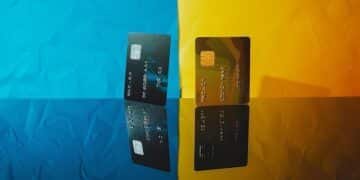Get a Credit Card with Bad Credit: Your Step-by-Step Guide

Getting a credit card with bad credit can seem daunting, but this guide provides a step-by-step approach to improving your chances, exploring secured cards, and comparing options to rebuild your credit effectively.
Having bad credit can make many financial tasks more difficult, including getting approved for a credit card with bad credit. But don’t worry; it’s not impossible. This guide will walk you through the steps you can take to improve your chances and rebuild your credit history.
Understanding Bad Credit and its Impact
Before diving into the solution, it’s crucial to understand what constitutes bad credit and how it affects your financial opportunities. This involves learning about credit scores and how they influence lenders’ decisions.
Defining Bad Credit
Bad credit is generally defined as a credit score below 630 on the FICO scale, which ranges from 300 to 850. Scores between 300 and 579 are considered “very poor,” while those between 580 and 669 are labeled “fair.” A lower credit score often indicates a higher risk to lenders.
Impact on Financial Opportunities
A bad credit score can affect several aspects of your financial life. Here are some of the key areas:
- Credit Card Approvals: It’s harder to get approved for standard credit cards with attractive interest rates and rewards programs.
- Loan Interest Rates: You’ll likely face higher interest rates on loans, such as auto loans or personal loans, increasing the overall cost of borrowing.
- Rental Applications: Landlords often check credit scores during the application process. A low score can reduce your chances of securing an apartment.
- Insurance Premiums: Some insurance companies use credit scores to determine premiums. Poor credit can lead to higher insurance costs.
Understanding these impacts can motivate you to take the necessary steps to improve your credit profile. Ignoring the problem can lead to long-term financial challenges.

In conclusion, understanding what qualifies as bad credit and recognizing its potential impact on your financial future is the first step toward improving your creditworthiness and securing better financial opportunities.
Step 1: Check Your Credit Report
The initial step towards obtaining credit with bad credit is knowing exactly where you stand. This involves checking your credit report for errors and understanding the factors affecting your score.
Obtain Your Credit Reports
You are entitled to one free credit report annually from each of the three major credit bureaus: Experian, Equifax, and TransUnion. You can access these reports through AnnualCreditReport.com.
Review for Errors
Carefully review each credit report for inaccuracies, such as:
- Incorrect account balances
- Accounts that don’t belong to you
- Duplicate accounts
- Outdated negative information
Dispute Inaccuracies
If you find any errors, dispute them with the credit bureau that issued the report. Here’s how:
- Write a Dispute Letter: Clearly explain the error and provide supporting documentation.
- Submit Your Dispute: Send your dispute letter to the credit bureau via certified mail with return receipt requested.
- Follow Up: The credit bureau has 30 days to investigate and respond to your dispute.
Correcting errors on your credit report can lead to an immediate improvement in your credit score, making it easier to qualify for credit cards.
To summarize, checking your credit report, identifying and disputing errors, allows consumers to lay the groundwork for improving their credit situation and increasing their chances of securing a credit card.
Step 2: Consider a Secured Credit Card
One of the most accessible options for those with bad credit is a secured credit card. This type of card requires a cash deposit that acts as collateral, reducing the risk for the issuer.
How Secured Cards Work
A secured credit card works similarly to a regular credit card, but with a significant difference: you provide a cash deposit that typically serves as your credit limit. For example, a $300 deposit usually secures a $300 credit limit.
Benefits of Secured Cards
Secured cards offer several advantages for those trying to rebuild their credit:
- Higher Approval Rate: They are easier to obtain compared to unsecured cards because the deposit reduces the lender’s risk.
- Credit Building: Responsible use of a secured card, including making timely payments, can help improve your credit score over time.
- Transition to Unsecured Cards: Many issuers offer the option to upgrade to an unsecured card after a period of responsible use.
Choosing the Right Secured Card
When selecting a secured credit card, consider the following:
- Annual Fee: Look for cards with low or no annual fees.
- Interest Rate (APR): While not the primary focus, compare APRs to minimize interest charges if you carry a balance.
- Reporting to Credit Bureaus: Ensure the card issuer reports your payment activity to all three major credit bureaus.
Selecting the right secured credit card involves comparing fees, interest rates, and reporting practices to ensure it aligns with your credit-building goals.

In summary, opting for a secured credit card can be an accessible way to start rebuilding credit, provided you choose a card with favorable terms and use it responsibly.
Step 3: Explore Unsecured Credit Cards for Bad Credit
While secured cards are a common option, some unsecured credit cards are specifically designed for individuals with less-than-perfect credit. These cards typically come with higher fees and interest rates, but they don’t require a deposit.
Understanding Unsecured Options
Unsecured credit cards for bad credit offer a way to build credit without putting down a cash deposit. However, it’s essential to understand their terms and conditions thoroughly.
Comparing Fees and Interest Rates
These cards often come with:
- Higher APRs: Interest rates can be significantly higher than those of standard credit cards.
- Annual Fees: Many cards charge annual fees, which can reduce the overall value of the card.
- Other Fees: Be aware of fees like application fees, monthly maintenance fees, and late payment fees.
Cards to Consider
Some unsecured credit cards targeted at individuals with bad credit include:
- OpenSky Secured Visa Credit Card: Does not require a credit check.
- Credit One Bank Visa: Reports to all three major credit bureaus and offers cash back rewards.
Carefully compare the fees, interest rates, and benefits of different unsecured cards to find the one that best suits your needs and offers the most value.
Ultimately, exploring unsecured credit cards for bad credit can provide a pathway to rebuilding your credit without a cash deposit, but requires careful comparison of fees and interest rates to ensure affordability.
Step 4: Become an Authorized User
Another strategy to consider is becoming an authorized user on someone else’s credit card account. This allows you to benefit from their good credit history, helping you build your own.
How it Works
Being an authorized user means you are added to someone else’s credit card account and receive a card in your name. The account activity is reported to your credit report, which can help improve your score if the primary cardholder manages the account responsibly.
Benefits and Risks
Benefits:
- Credit Building: Positive payment history and a low credit utilization ratio on the primary account can boost your credit score.
- Access to Credit: You gain access to a credit card without undergoing a credit check.
Risks:
- Dependency on Primary Cardholder: Your credit score is tied to the primary cardholder’s behavior. Late payments or high credit utilization can negatively affect your score.
- Account Closure: If the primary cardholder closes the account, it could negatively impact your credit history.
Choosing the Right Account
When becoming an authorized user, ensure the primary cardholder:
- Has a long history of responsible credit use.
- Maintains a low credit utilization ratio.
- Pays their bills on time.
In conclusion, becoming an authorized user presents a viable strategy for boosting credit scores by leveraging the responsible credit behavior of another person, but demands careful consideration of their credit habits and the potential risks involved.
Step 5: Practice Responsible Credit Card Usage
Simply getting a credit card is not enough; it’s essential to use it responsibly to build and maintain good credit. This involves managing your spending, paying bills on time, and keeping your credit utilization low.
Managing Your Spending
Keep your spending within your means to avoid accumulating high balances. Create a budget and track your expenses to stay on top of your credit card usage.
Paying Bills on Time
Payment history is a significant factor in your credit score. Always pay your credit card bills on time, every time. Consider setting up automatic payments to avoid missed deadlines.
Keeping Credit Utilization Low
Credit utilization—the amount of credit you’re using compared to your credit limit—also plays a crucial role. Aim to keep your credit utilization below 30% to show lenders you’re a responsible borrower.
Monitoring Your Credit Score
Regularly monitor your credit score to track your progress and identify any potential issues. Many credit card issuers offer free credit score monitoring as a perk. Also, you can use websites like Credit Karma or Credit Sesame.
In order to foster a positive credit card utilization it is important to track your progress and make any helpful adjustments to your goals.
Step 6: Consider a Credit-Builder Loan
If credit cards aren’t your preference, or if you want to diversify your credit-building methods, consider a credit-builder loan. These loans are specifically designed to help people with bad credit improve their credit scores.
How Credit-Builder Loans Work
With a credit-builder loan, you don’t receive the funds upfront. Instead, the lender places the loan amount in a secured account. You’ll make monthly payments over a set period. Once you’ve paid off the loan, you receive the funds, and your payment history is reported to the credit bureaus.
Benefits of Credit-Builder Loans
- Build Credit: Each on-time payment helps improve your credit score.
- Savings Opportunity: You’ll accumulate savings as you pay off the loan.
- Low Risk: Because the loan is secured, there’s less risk for the lender, making it easier to get approved.
Finding a Credit-Builder Loan
Credit-builder loans are available through:
- Credit Unions: Often offer these loans to members.
- Community Banks: May provide credit-builder loans to local residents.
- Online Lenders: Several online lenders specialize in credit-builder loans.
Ultimately, choosing a credit-builder loan can serve as a structured method for enhancing credit scores because of the savings opportunity, especially if combined with other credit-building strategies.
| Key Point | Brief Description |
|---|---|
| 🔍 Check Credit Report | Review and dispute any inaccuracies to improve your score. |
| 💳 Secured Credit Card | Requires a deposit but offers easy approval for credit building. |
| 💸 Credit-Builder Loan | Helps build credit by making payments; funds are released after loan completion. |
| 👨💼 Authorized User | Being added to someone else’s credit card helps build credit. |
Frequently Asked Questions
A credit score below 630 is generally considered bad credit. This is based on the FICO scoring model, which ranges from 300 to 850.
Yes, it’s possible, but your options might be limited to secured credit cards or unsecured cards specifically designed for bad credit, which often come with higher fees.
It can take anywhere from several months to a few years to rebuild bad credit, depending on how consistently you practice good financial habits like paying bills on time.
A secured credit card requires a cash deposit that acts as collateral. Your credit limit is usually equal to the deposit amount, making it easier to get approved even with bad credit.
Look for cards with low annual fees, transparent terms, and those that report your payment activity to all three major credit bureaus to help you rebuild your credit.
Conclusion
Obtaining a credit card with bad credit requires a strategic approach that includes understanding your credit situation, exploring available options like secured and unsecured cards, and consistently practicing responsible credit usage. By following these steps, you can gradually rebuild your credit and improve your financial opportunities.





